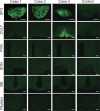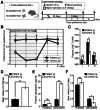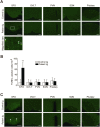Adipsic hypernatremia without hypothalamic lesions accompanied by autoantibodies to subfornical organ
- PMID: 27338632
- PMCID: PMC8029419
- DOI: 10.1111/bpa.12409
Adipsic hypernatremia without hypothalamic lesions accompanied by autoantibodies to subfornical organ
Abstract
Adipsic (or essential) hypernatremia is a rare hypernatremia caused by a deficiency in thirst regulation and vasopressin release. In 2010, we reported a case in which autoantibodies targeting the sensory circumventricular organs (sCVOs) caused adipsic hypernatremia without hypothalamic structural lesions demonstrable by magnetic resonance imaging (MRI); sCVOs include the subfornical organ (SFO) and organum vasculosum of the lamina terminalis (OVLT), which are centers for the monitoring of body-fluid conditions and the control of water and salt intakes, and harbor neurons innervating hypothalamic nuclei for vasopressin release. We herein report three newly identified patients (3- to 8-year-old girls on the first visit) with similar symptoms. The common features of the patients were extensive hypernatremia without any sensation of thirst and defects in vasopressin response to serum hypertonicity. Despite these features, we could not detect any hypothalamic structural lesions by MRI. Immunohistochemical analyses using the sera of the three patients revealed that antibodies specifically reactive to the mouse SFO were present in the sera of all cases; in one case, the antibodies also reacted with the mouse OVLT. The immunoglobulin (Ig) fraction of serum obtained from one patient was intravenously injected into wild-type mice to determine whether the mice developed similar symptoms. Mice injected with a patient's Ig showed abnormalities in water/salt intake, vasopressin release, and diuresis, which resultantly developed hypernatremia. Prominent cell death and infiltration of reactive microglia was observed in the SFO of these mice. Thus, autoimmune destruction of the SFO may be the cause of the adipsic hypernatremia. This study provides a possible explanation for the pathogenesis of adipsic hypernatremia without demonstrable hypothalamus-pituitary lesions.
Keywords: adipsic hypernatremia; autoimmune disease; essential hypernatremia; sensory circumventricular organs.
© 2016 International Society of Neuropathology.
Conflict of interest statement
The authors declare no conflict of interest.
Figures




References
-
- Andersson B, Leksell LG, Rundgren M (1982) Regulation of water intake. Annu Rev Nutr 2:73–89. - PubMed
-
- Avioli LV, Earley LE, Kashima HK (1962) Chronic and sustained hypernatremia, absence of thirst, diabetes insipidus, and adrenocorticotrophin insufficiency resulting from widespread destruction of the hypothalamus. Ann Intern Med 56:131–140. - PubMed
-
- Bappal B, Sheikh HA, Radhakrishan A, Mula‐Abed WA (2006) Adipsic hypernatremia with a reset osmostat. Saudi Med J 27:727–729. - PubMed
-
- Cauble MS, Mack‐Shipman L, Schaefer GB, Balakrishnan S, Larsen JL (2001) Idiopathic hypothalamic dysfunction with precocious puberty and adipsic hypernatremia first presenting in adolescence. J Pediatr Endocrinol Metab 14:1163–1167. - PubMed
-
- Conley SB, Brocklebank JT, Taylor IT, Robson AM (1976) Recurrent hypernatremia: a proposed mechanism in a patient with absence of thirst and abnormal excretion of water. J Pediatr 89:898–903. - PubMed
Publication types
MeSH terms
Substances
LinkOut - more resources
Full Text Sources
Other Literature Sources

